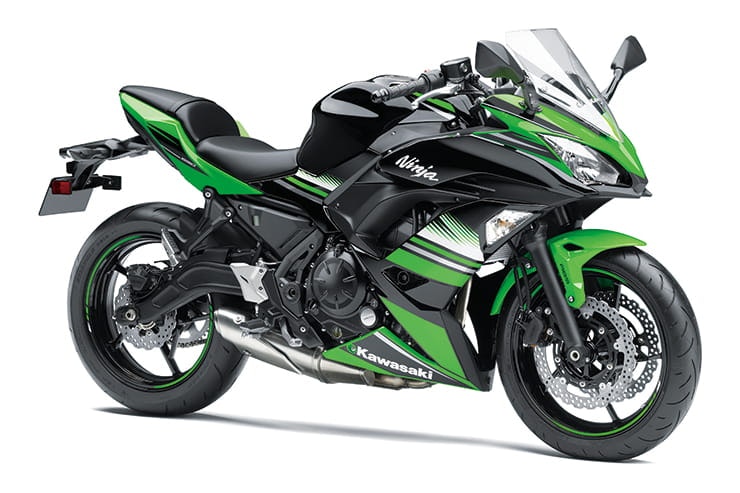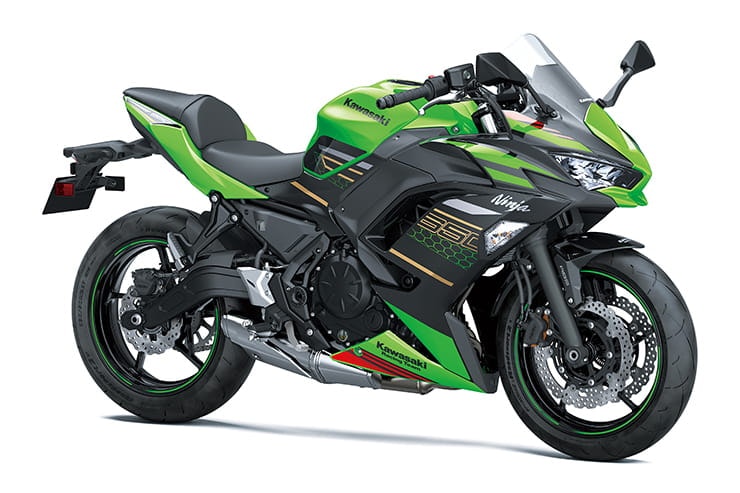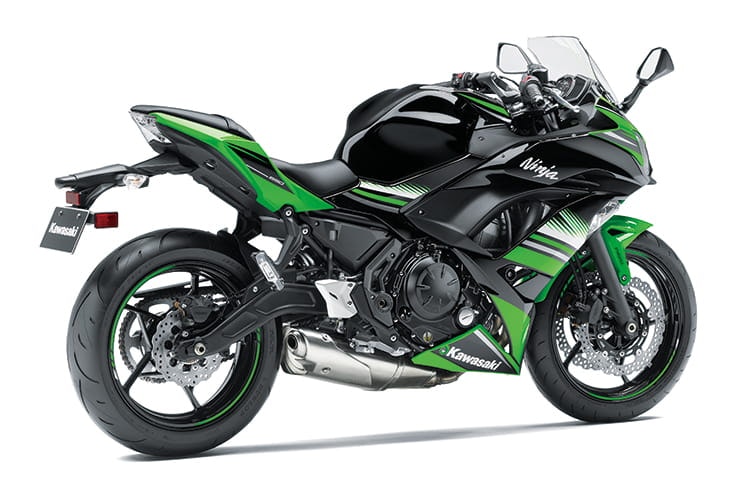Kawasaki Ninja 650 (2017-current): Review & Buying Guide
By Jon Urry
Massively experienced road tester
27.03.2024
Price: £3500-£8000 | Power: 67bhp | Weight: 193kg | Overall BikeSocial Rating: 4/5
At the moment there is a definite revival happening in the middleweight sportsbike class with the likes of the Suzuki GSX-8R and Triumph Daytona 660 being launched this year after the Aprilia RS660, Honda CBR650R and Yamaha R7 rejuvenated the category. However, for one bike the popularity of this segment comes as no surprise – the Kawasaki Ninja 650. This fully-faired middleweight has been around in some shape or form since 2006 and has been a steady seller for the firm thanks to its easy-going nature and strong parallel twin motor. Rebranded the Ninja 650 in 2017 (although basically the same bike as the ER-6f that predated it only much better looking), the mini-Ninja isn’t at the forefront of middleweight sportsbike design but if you are after a cool-looking sporty middleweight, a Ninja 650 makes for an excellent used buy. And one that is far, far, cheaper than a new model...
Strong motor
Tempting price tag
Good handling
A bit old-school in both looks and feel
The engine isn’t that quick-revving or powerful
The suspension could be a bit better
Kawasaki Ninja 650 (2017-current) Price
When it was launched in 2017 the Ninja 650 cost a very reasonable £6349 (plus £200 for the green/black race team paint) and came with the option of being ordered in Touring variant (panniers, taller screen and a few more goodies) for £600 more or Performance Edition (Akra can, pillion seat cover, smoked flyscreen) for an extra £950 over the stock bike. Nowadays you can pick up a well-used Ninja for around £3500 in the used market however while they are very solid bike, you are probably better off saving up £4500 to get one with less miles on its clocks. If you really want the TFT dash (introduced in 2020) you are looking at closer to £5000 while one with traction control (2023-onwards) is just under £6000. Brand new or pre-registered 2023 bikes are being discounted from their RRP of £7539 to £5999, which is worth considering as you get a new warranty and possibly a bit of a deal on finance. Going for a Touring or Performance model adds about £300 to the used price tag.
Engine and Performance
The Ninja is powered by Kawasaki’s workhorse of a parallel twin motor, which was actually upgraded in 2017 when it became the Ninja 650 through new cams, reworked intake ports and modifications to its fuelling system – although these tweaks were mainly aimed at meeting new emission regs rather than performance gains. The same is true of the 2020 airbox upgrade, which was emissions-pleasing but also gives the bike a bit of a throatier note. But have Kawasaki taken their eye off the ball with the Ninja’s engine? Arguably yes.
Ridden in isolation there is little to complain about when it comes to the Ninja 650’s engine. A really beautiful motor with a thumping old-school feel and lots of mid-range drive, it’s a tried and tested unit with a solid reputation for reliability and user-friendly feel. In or out of town it gets on with the job in hand and thanks to a fairly slick gearbox and light clutch action, there isn’t much to find fault with. But then you ride one of the modern parallel twins, or Triumph’s 660 triple, and the Ninja instantly feels dated as it is undeniably far slower revving, lacking in instant drive and a bit vibey despite its rubber-mounted bars and rubber-cushioned pegs. Is this a bad thing? Yes and no, the Ninja’s more old-school feel certainly has its advantages as it is gruntier low-down, but it isn’t as fun to ride as its more modern rivals and that’s a shame. It’s a solid motor, not an inspiring one.
When it comes to buying used, there is nothing to worry about with the Ninja’s engine. As it is fairly new you can buy with total confidence and after checking the consumable items (chain, sprockets etc) and inspecting its service history (7500-mile intervals, valve-clearances at 15,000, expect to pay about £300 and £600 respectively) all should be well. Remember the exhaust is a one-piece unit, so if it is dented or damaged (or has a horrifically loud aftermarket pipe on) you will need to remove the whole thing, which can be tricky if the exhaust studs are badly corroded.
Kawasaki Ninja 650 (2017-current) Handling & Suspension
There is lots to like about the Ninja 650 when it comes to its chassis – but also quite a bit to be left rather cold by. Starting with the bad, it is undeniably very dated in terms of both its tech (where’s the quickshifter?) and its visual appeal. The two-piston sliding calipers aren’t radially-mounted, the forks are telescopic in their design rather than inverted and the fairing doesn’t hug the Ninja’s body in the same fluid way as sportier rivals, giving the impression it has been rather bolted-on. But it has to be said, in racing green the 650 does look a proper Ninja product and its aggressive headlights instantly shout ‘Ninja’ at you. And it rides well too, as long as you aren’t pushing on too hard.
Sporty but not over-the-top, the Ninja is a good handling bike that although a bit soft on its suspension (which is only adjustable for preload on the shock) is more than happy to whip down a B-road at a spirited pace. The two-piston sliding calipers bite the wave discs with a good amount of feel as well as power and the suspension is compliant enough to keep everything in check and deliver a confidence-inspiring ride quality. It’s certainly sporty enough to justify its Ninja branding but never feels over-the-top - however compared to a Yamaha R7 or Aprilia RS660, it is definitely a generation behind in terms of its chassis and isn’t really a machine you would consider taking on a track day. There again, is it meant to be? It’s a road sportsbike and on that front, the Ninja is a good handling bike. Not outstanding but good and certainly won’t disappoint.
As with the motor, there isn’t much to be worried about on the Ninja’s chassis when buying used aside from crash damage, wear and tear and consumable items nearing the end of their life.
Comfort & Economy
The Ninja 650 is a Ninja in name only, certainly not riding position! Its clip-on bars are set well above the top yoke and its pegs low, which adds up to a pleasingly relaxed and comfortable riding position, even for taller riders. Adding heated grips or a taller screen (you can also get a more padded accessory seat) certainly helps comfort levels but overall, it’s not a bad bike and certainly works well as a commuter.
In terms of economy, averaging mid-50mpg figures is very easy with 60mpg and possibly even 65mpg certainly on the cards. That equates to a fuel range of well over 150 miles from its 15-litre tank, which is more than enough and makes the Ninja quite frugal to run.
Kawasaki Ninja 650 (2017-current) Equipment
Despite only being launched in 2017, there have been a few notable upgrades to the Ninja 650 that you need to be aware of. The Ninja has always had ABS as standard but in 2020 the Kawasaki gained the firm’s colour TFT dash with inbuilt connectivity, which is nice to have but not really a deal-breaker as the older LCD display is certainly acceptable and has a gear indicator and fuel gauge. In 2023 the Ninja gained two-level TC (which was debuted on the Versys 650 a year before), which is a pleasing safety assist to see but not entirely necessary on a bike with limited power and quite friendly motor characteristics. To be fair, the fact Kawasaki upgraded the tyres in 2020 from Dunlop D21 to Sportmax Roadsport 2 tyres was probably more important when it came to preventing the rear losing traction...
If you are considering using the Ninja as a commuter or mini tourer then a bike with the Touring package (larger screen, semi-rigid panniers, tank pad, knee pads and frame sliders) is worth looking out while the Performance Edition (smoked flyscreen, tank pad, pillion seat cover and road-legal Akrapovič exhaust) is the more head-turning option. Both variants are plentiful in the used market and if you only want one or two of the extras, they are all available separately from Kawasaki dealers, although it is obviously cheaper to buy a bike with them already fitted. Other than these official extras, it is the usual story with tail tidies, heated grips, etc common accessories – and a centre stand, which isn’t standard fitment. Loud pipes are also quite common and generally best avoided, go for a Performance Edition with the fruitier, but still road legal, Akrapovič fitted.
Kawasaki Ninja 650 (2017-current) Rivals
Ninja 650s are generally bought by newer riders or those on a restricted licence, however their lighter weight also makes them popular with riders who want a sporty-looking bike but don’t want the associated weight, price or excessive power of a full-on litre bike.
Yamaha R7 (2022-current) | Approx Price: £6000-£9000
Power/Torque: 72bhp/49lb-ft | Weight: 188kg
Honda CBR650R (2019-current) | Approx Price: £5000-£8000
Power/Torque: 94bhp/46lb-ft | Weight: 207kg
Aprilia RS660 (2021-current) | Approx Price: £7000-£11,000
Power/Torque: 99bhp/49lb-ft | Weight: 183kg
Kawasaki Ninja 650 (2017-current) Verdict
Against the current crop of faired middleweights, the Ninja 650 is decidedly old-school in its feel. Slower revving and not as visually appealing at due to its lower spec level, the Ninja is easily overlooked. However, take one for a test ride and you will discover this charming sporty bike makes for a great, and frugal, middleweight that handles well and has a spirited motor. One to buy used and be happy at your saving over a new R7, RS660, GSX-8R or Daytona 660 - not necessarily rush out and buy box-fresh.
If you’d like to chat about this article or anything else biking related, join us and thousands of other riders at the Bennetts BikeSocial Facebook page.
Kawasaki Ninja 650 (2017-current) – Technical Specification
Looking for motorcycle insurance? Get a quote for this motorbike with Bennetts bike insurance


